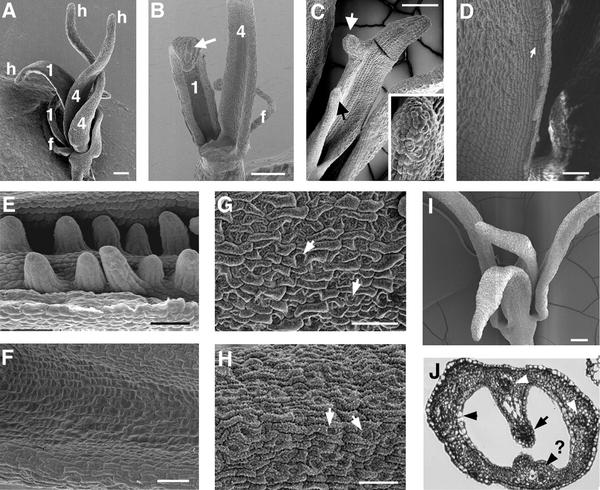Figure 3.
Gynoecium Marginal Tissues Are Absent in lug ant Double Mutants.
(A) The flower of a lug-3 ant-9 double mutant having a total of five floral organs. The filament (f) represents a third-whorl organ. The other four organs all have characteristics of carpel valves, such as horns (h) and epidermal cell morphology. Two of these organs (both labeled 1) are first- whorl organs, and the other two organs (labeled 4) are fourth-whorl organs. Ovule, septum, stigma, and style are absent.
(B) A dissected lug-3 ant-9 double mutant flower. Shown is the adaxial (inner) surface of a fourth-whorl (4) and a first-whorl (1) organ. A stamen filament (f) is visible. The first-whorl organ exhibits features of sepals as well as carpels; the long cell (arrow) on the abaxial surface is characteristic of sepals, whereas the thickening of the edge is characteristic of carpels. Ovule, stigma, and style were not detected in the first-whorl organs or in the fourth-whorl organs.
(C) A lug-3 ant-9 double mutant fourth-whorl carpel. Nublike protrusions (arrows) at the edge of the valve display surface morphology characteristic of horns. The inset shows a magnification (×4) of the nub (indicated by the black arrow).
(D) A close-up of the outer edge of an unfused lug-3 ant-9 fourth-whorl carpel. The rectangular cells (arrow) are characteristic of cells at the edge of carpel valves.
(E) A close-up of the inner surface of a lug-1 gynoecium. Two rows of ovules are initiated from the placenta.
(F) A close-up of the inner surface of a mature fourth-whorl organ in a lug-3 ant-9 double mutant. Note the absence of any ovule primordium.
(G) A close-up of the abaxial epidermal surface of a wild-type Ler carpel valve. Immature stomata cells (arrows) and epicuticular wax are visible.
(H) A close-up of the abaxial epidermal surface of a lug-3 ant-9 fourth-whorl organ. The immature stomata cells (arrows) and epicuticular wax (small white dots over the entire surface) are characteristic of carpel valves and are similar to the wild type, as shown in (G). The more developed stomata and the more prominent wax than those in (G) reflect the older age of this flower.
(I) A lug-1 ant-9 double mutant flower. None of the floral organs bears any marginal tissues.
(J) A cross-section of a stage 13 gynoecium of a lug-1 ant-9 double mutant. No ovule is formed, although some septal tissue is present. Three vascular bundles are visible (arrowheads). The fourth (indicated by an arrowhead and a question mark) is less developed. A transmitting tract is also present (arrow).
 ;
;  .
.

